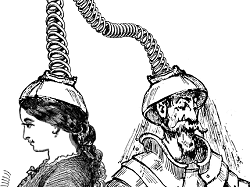 The new film Self/less is based around the transfer of consciousness. An old man buys a new body to transfer into, and then finds that contrary to what he was told, it wasn’t grown specially: there was an original tenant who moreover, isn’t really gone. I understand that this is not a film that probes the metaphysics of the issue very deeply; it’s more about fight scenes; but the interesting thing is how readily we accept the idea of transferred consciousness.
The new film Self/less is based around the transfer of consciousness. An old man buys a new body to transfer into, and then finds that contrary to what he was told, it wasn’t grown specially: there was an original tenant who moreover, isn’t really gone. I understand that this is not a film that probes the metaphysics of the issue very deeply; it’s more about fight scenes; but the interesting thing is how readily we accept the idea of transferred consciousness.
In fact, it’s not at all a new idea; if memory serves, H.G.Wells wrote a short story on a similar theme; a fit young man with no family is approached by a rich old man in poor health who apparently wants to leave him all his fortune; then he finds himself transferred unwillingly to the collapsing ancient body and the old man making off in his fresh young one. In Wells’ version the twist is that the old man gets killed in a chance traffic accident, thereby dying before his old body does anyway.
The thing is, how could a transfer possibly work? In Wells’ story it’s apparently done with drugs, which is mysterious; more normally there’s some kind of brain-transfer helmet thing. It’s pretty much as though all you needed to do was run an EEG and then reverse the polarity. That makes no sense. I mean, scanning the brain in sufficient detail is mind-boggling to begin with, but the idea that you could then use much the same equipment to change the content of the mind is in another league of bogglement. Weather satellites record the meteorology of the world, but you cannot use them to reset it. This is why uploading your mind to a computer, while highly problematic, is far easier to entertain than transferring it to another biological body.
The big problem is that part of the content of the brain is, in effect, structural. It depends on which neurons are attached to which (and for that matter, which neurons there are), and on the strength and nature of that linkage. It’s true that neural activity is important too, and we can stimulate that electrically; even with induction gear that resembles the SF cliché: but we can’t actually restructure the brain that way.
The intuition that transfers should be possible perhaps rests on an idea that the brain is, as it were, basically hardware, and consciousness is essentially software; but isn’t really like that. You can’t run one person’s mind on another’s brain.
There is in fact no reason to suppose that there’s much of a read-across between brains: they may all be intractably unique. We know that there tends to be a similar regionalisation of functions in the brain, but there’s no guarantee that your neural encoding of ‘grandmother’ resembles mine or is similarly placed. Worse, it’s entirely possible that the ‘meaning’ of neural assemblages differs according to context and which other structures are connected, so that even if I could identify my ‘grandmother’ neurons, and graft them in in place of yours, they would have a different significance, or none.
Perhaps we need a more sophisticated and bespoke approach. First we thoroughly decipher both brains, and learn their own idiosyncratic encoding works. Then we work out a translator. This is a task of unimaginable complexity and particularity, but it’s not obviously impossible in principle. I think it’s likely that for each pair of brains you would need a unique translator: a universal one seems such an heroic aspiration that I really doubt its viability: a universal mind map would be an achievement of such interest and power that merely transferring minds would seem like time-wasting games by comparison.
I imagine that even once a translator had been achieved, it would normally only achieve partial success. There would be a limit to how far you could go with nano-bot microsurgery; and there might be certain inherent limitations. Certain ideas, certain memories, might just be impossible to accommodate in the new brain because of their incompatibility with structural or conceptual issues that were too deeply embedded to change; there would be certain limitations. The task you were undertaking would be like the job of turning Pride and Prejudice into Don Quixote simply by moving the words around and perhaps in a few key cases allowing yourself one or two anagrams: the result might be recognisable, but it wouldn’t be perfect. The transfer recipient would believe themselves to be Transferee, but they would have strange memory gaps and certain cognitive deficits, perhaps not unlike Alzheimer’s, as well as artefacts: little beliefs or tendencies that existed neither in Transferee or Recipient, but were generated incidentally through the process of reconstruction.
It’s a much more shadowy and unappealing picture, and it makes rather clearer the real killer: that though Recipient might come to resemble Transferee, they wouldn’t really be them.
In the end, we’re not data, or a program; we’re real and particular biological entities, and as such our ontology is radically different. I said above that the plausibility of transfers comes from thinking of consciousness as data, which I think is partly true: but perhaps there’s something else going on here; a very old mental habit of thinking of the soul as detachable and transferable. This might be another case where optimists about the capacity of IT are unconsciously much less materialist than they think.
Selfless Transfers
47
